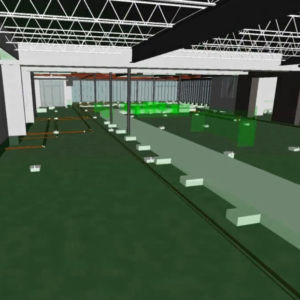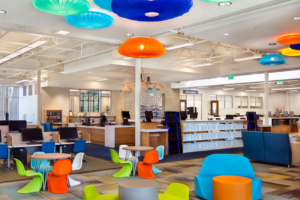
While the academic community debates whether or not books have any future in light of the rapid development of digital information technology, libraries are getting ready for the future by making changes to the very buildings they call home. Atlanta’s newly built Metropolitan Library, which is a southside branch library of the Atlanta-Fulton Public Library System, includes a raised access floor as part of its innovative design.
Raised Floor Basics
What does a raised floor have to do with getting ready for the digital revolution? A raised access floor is an elevated structural floor above the solid substrate that creates space for mechanical and electrical systems. The Metropolitan Library’s raised floor is 18 inches high, and consists of a flat steel top and a profiled steel base, which are welded together to form a shell and filled with a cementitious core material.

Winter Johnson Group used building information modeling to assist in the preparation and installation of the Library’s raised floor.
Located in the space created below the raised floor, mechanical and electrical systems can perform efficiently.The mechanical system is highly accessible by the building’s users, who can reach and control conditioning vents to improve occupant comfort. The Metropolitan Library’s interior has a very open floor plan, a type of space that creates large, stratified air distributions. Warm air rises and collects near the ceiling, while cool air sinks and collects near the floor, closer to where the occupants are. By locating the air system under the floor, the design takes advantage of air stratification. When warm air is needed, the air system supplies warm air directly to where the occupants are. When cool air is needed, less propulsion of the air is needed to reach the occupants and replenish the cooled area.
Advancing the Library’s Mission
So how does the Metropolitan Library’s raised access floor help to advance the Library’s mission to keep up with ongoing digital innovations? According to the Library’s designer, Smith Dalia Architects, the library program specifically required a plan for accommodating a 10 percent user-growth factor in the new branch library. The best solution for growth was to capitalize on the technological innovations related to library services. Library planners predict that over time, less and less floor space will be allocated for books and paper-based media.

The Library’s design takes advantage of the open space around the ceiling, since conduit and electrical elements are below the floor.
The floor space that is opened up by the transition to a paperless environment can accommodate more users who will utilize “virtual” library collections. In order to maximize the impact of this trend, the raised access flooring (in combination with a very open floor plan) allows for endless reconfiguration of library program elements. The library can easily move furniture and change the placement of library casework. There is no need to move vents or ducts as the library changes its layout. By removing a few floor tiles, certain sections of the floor are accessible and air flow can be redirected to accommodate any area.
Smith Dalia naturally took advantage of the open space around the ceiling at Metropolitan Library, since conduit and electrical elements are located below the floor. The interior feels spacious and full of natural light, with joyful points of color in the pendant light fixtures. The raised access flooring system also provides designers with great flexibility in floor coverings, since it can accommodate a broad range of options, including carpet, laminate, and wood. For the Metropolitan Library, the designers used carpet for the majority of the public areas to create a quiet environment.
Innovations and Problem-Solving
During Winter Johnson Group’s construction of Metropolitan Library, the raised access flooring system presented concern because, once the mechanical system was installed under the floor, its position there made it vulnerable to the dust created by the constant travel of trade workers in and out of the building. The intensely dusty environment could have jeopardized the functioning of the HVAC and could have thereby delayed dry-in. Winter sought solutions for reducing the dust, and, among other things, decided to prioritize the pouring of the entrance slab. Once hardening of the entrance was complete, Winter required all foot traffic to enter the building by that main entrance.
When Winter Johnson Group completed construction, Fulton County, and the Atlanta-Fulton Public Library System could justifiably claim that their new and innovative branch library would be the envy of other branch libraries everywhere.



